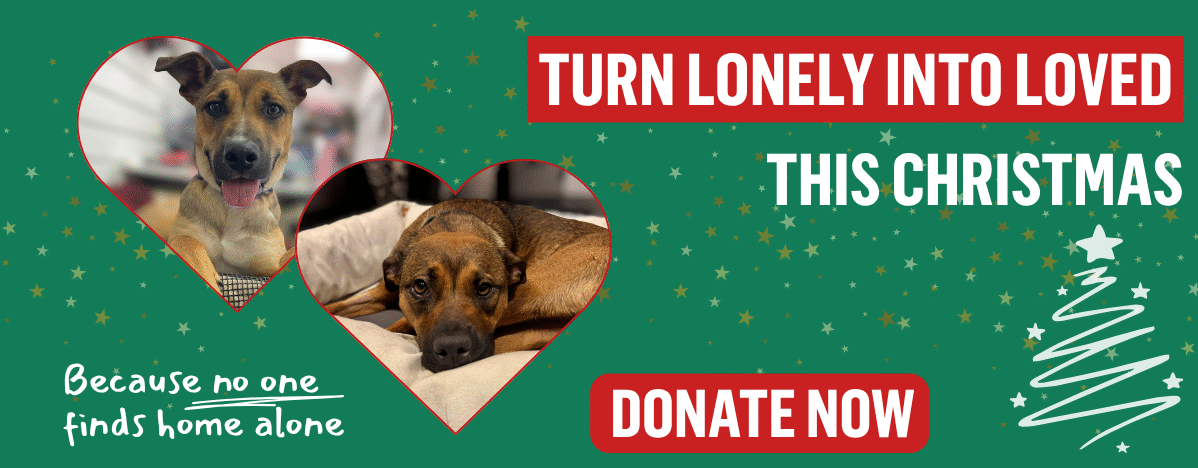BLOG
Senior Pet Project: Feeble to Forever Home
12-year-old Finbar looked worse for wear when he was brought to the Home by a council ranger in June. He had lumps growing in strange places, sore knees, a loose claw, excess weight and hadn’t seen the dentist in a while. Luckily, he’d come to the right place.
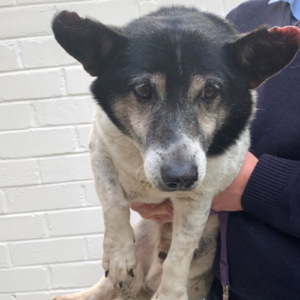 After thorough examinations by our vet team, including x-rays and lab tests, Finbar was found to have osteoarthritis of both knees, a benign testicular tumour, a benign rectum mass, umbilical hernia and mild dental disease. This unpleasant combination of ailments made life very uncomfortable for Finbar, so our vet team quickly got to work to get him ready for the retirement he deserves.
After thorough examinations by our vet team, including x-rays and lab tests, Finbar was found to have osteoarthritis of both knees, a benign testicular tumour, a benign rectum mass, umbilical hernia and mild dental disease. This unpleasant combination of ailments made life very uncomfortable for Finbar, so our vet team quickly got to work to get him ready for the retirement he deserves.
Finbar’s treatment started with dental surgery, claw removal and a weight loss plan. His testicular tumour was removed during his desexing appointment, which should also reduce his hormone levels and resolve the mass in his rectum. Just to make sure it settles though, his wonderful adopter has committed to monitoring the mass.
Finbar seemed to be doing okay with his umbilical hernia, which causes fat to protrude through the muscle wall, but there was still a small risk organs like intestines could herniate as well. This wasn’t a risk we were willing to take, so surgery was performed to repair the hernia and Finbar recovered with ease.
While we discovered Finbar’s joint condition was too advanced for surgery, our vet team determined it can be managed with ongoing anti-inflammatories and joint supplements that allow him to move comfortably. Within days of this treatment being prescribed, his foster carer noted he was very comfortable and was so excited by walks he would jump up and down in anticipation for the lead.
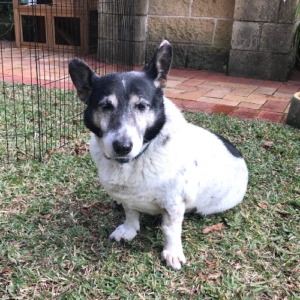 Finbar was really fortunate to have a comfy foster home where he could recover from his procedures, but he wasn’t there for long! Shortly after Finbar was ready for adoption, he was swept up by his new mum Claudia.
Finbar was really fortunate to have a comfy foster home where he could recover from his procedures, but he wasn’t there for long! Shortly after Finbar was ready for adoption, he was swept up by his new mum Claudia.
Claudia told us he’s fit really well into her home, where he’s a much loved member of the family. He loves being with his humans, who are doing a great job managing his health. He’s still going for vet checks and is continuing on pain medication so he can enjoy his daily walks without any pain. It sounds like he’s doing really well!
As Sydney’s only charity pound and community facility, we rely on donations to give senior pets a second chance in life. Donate today to the Senior Pet Project to give pets like Finbar the care and treatment they need to thrive in their twilight years.
ABOUT THE SENIOR PET PROJECT
In its second year, our Senior Pet Project was started as an initiative not only to put a spotlight on golden oldies to help with their rehoming, but also to raise the funds required for their much needed veterinary care and often prolonged stay at the Home.
With your support we are looking to raise $50,000 to help fund the Senior Pet Project in the months ahead, enabling us to give the seniors entering our care a new leash on life.
Room to Breathe: How We Fixed Up Two Frenchies
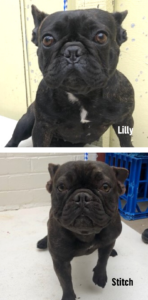 Stitch (previously Tilly) the French Bulldog arrived at the Home in May with her sister Lily. Sadly the microchip details were out-of-date, and we were unable to get her and her sister home.
Stitch (previously Tilly) the French Bulldog arrived at the Home in May with her sister Lily. Sadly the microchip details were out-of-date, and we were unable to get her and her sister home.
During routine vet checks, we noticed both Stitch and Lily were suffering from brachycephalic airway syndrome, a common condition in French Bulldogs caused by the ’squished’ appearance of their face. This condition causes breathing difficulties and other symptoms such as gagging, choking and regulating.
Stitch also had ear infections, diarrhoea, hemivertebrae (spine deformity) and a screw tail with deep tail fold dermatitis. She wasn’t living a very comfortable life.
Our vet team performed a surgery on both Stitch and Lily to open up their nose and airway as much as possible. Stitch also received an ear flush to resolve his ear infection. Both Frenchies recovered well, and with a few minor checks and procedures, Lily was ready for her forever home, and was adopted shortly after.
Stitch on the other hand required special surgery for her tail. Screw tail, otherwise known as ingrown tail, is a tail malformation found in certain dog breeds, causing inflammation, infection and pain. It requires very tricky surgery to remove the tail. To reduce the risk of complications, specialist surgeon Dr Newman from Sydney Vet Emergency & Specialists kindly performed the surgery from our Strathfield South clinic.
The surgery was a success and Stitch recovered with the help of some TLC in foster car and a special diet that resolved her diarrhoea. She still has a spine deformity, but so far, it isn’t affecting her quality of life, and her new adopter has committed to keeping an eye on her health.
Bubbles’ Battle with Cat Flu
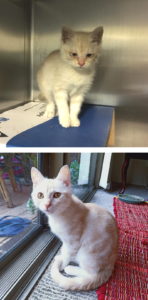 Five-week-old Bubbles came to us looking like she’d seen better days. She had a case of cat flu and conjunctivitis, with both eyes swollen and inflamed. Cat flu is a common disease in unvaccinated cats, easily spread from one feline friend to another, so it was important we acted quickly.
Five-week-old Bubbles came to us looking like she’d seen better days. She had a case of cat flu and conjunctivitis, with both eyes swollen and inflamed. Cat flu is a common disease in unvaccinated cats, easily spread from one feline friend to another, so it was important we acted quickly.
We administered antibiotic ointment twice a day for seven days, then sent her into medical foster care with Jill. Jill committed to Bubble’s treatment from day one, continuing with her twice daily ointment. Bubbles wasn’t a happy patient and put up a good fight, but the promise of chicken made it worth it every time. Bubbles’ symptoms came and went, so a few rounds of ointment had to be prescribed, but with persistence, her symptoms cleared.
Things were looking up for Bubbles, which is when the diarrhoea started. We did an analysis of her faeces with a microscope and discovered it contained nasty coccidia parasite eggs. With a special diet of Hill’s Prescription Diet i/d and medicated syrup, her diarrhoea resolved in just over a week.
During her treatment, Bubbles grew into the most beautiful kitten, much bigger and healthier than when she first arrived. Now that she was feeling better, she’d established a grooming routine which made her fur silky soft. Jill couldn’t help but fall for her furry foster, now foster fail.
Bubbles is now loving life with Jill in her forever home. Over time, she has become more confident and affectionate and has claimed her favourite spots around the house, including the cupboard on top of Jill’s shoes and the space between the heater and the wall.
Jill told us: “Despite the unpleasantness of the treatment, we feel like it helped to build trust with her and she’s now learnt to love being picked up, especially in the kitchen so she can see what’s going on. She has a very small meow but she’s using it a lot more now, to say hello or to find out where we are, but she saves her loudest and most persistent meows to ask us to come and play. Soon after we officially adopted her, we went away for a few days so we took her to stay with a friend. Since we’ve been back she seems to be calmer and happier and I think it’s because she knows now that this is her home and we are her people.”
Cat flu is a very common disease amongst cats and kittens, but not all of them have a happy ending like Bubbles. If you own a cat, it’s important to keep their vaccinations up to date, and prevent them from interacting with infected cats. This will significantly reduce their chances of contracting and spreading this highly contagious disease.
Fun fact: an easy way to ensure you’re getting a cat who’s been vaccinated is to adopt, don’t shop!
Old Fractures, New Beginning
 When the adorable Winston (previously Seattle) arrived at the Home, he seemed like your usual young cat. He was active and playful and enjoyed a good pat, but during his initial exam, our vet team noticed something very unusual. He was sitting with his legs in a strange position, and seemed uncomfortable being touched around his hips and hind limbs.
When the adorable Winston (previously Seattle) arrived at the Home, he seemed like your usual young cat. He was active and playful and enjoyed a good pat, but during his initial exam, our vet team noticed something very unusual. He was sitting with his legs in a strange position, and seemed uncomfortable being touched around his hips and hind limbs.
To investigate further, our team organised x-rays to examine Winston’s pelvis. The results showed he had old fractures, including complex fractures of his femurs and multiple fractures of his pelvis. Given the nature of the trauma, we suspect he was hit by a car several months earlier and had been walking around in a great deal of pain.
To provide Winston with a functional, pain-free outcome, surgery was performed to remove his fractured femoral heads. This resulted in a ‘pseudo-joint’, which should provide Winston with reasonable, comfortable function of his limbs long-term.
Winston recovered from his surgery in the comfort of foster care, and within two weeks, was moving around with no signs of pain.
Shortly after, on 10 August, he found his forever home!
Senior Pet Project: Sumo Finds Sanctuary
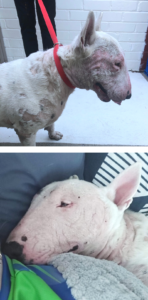 Sumo the senior Bull Terrier was in a sorry state when he came into the Home in June. His coat was patchy and speckled with blotches of inflamed skin, his eyes were cloudy and dry and he walked with a limp.
Sumo the senior Bull Terrier was in a sorry state when he came into the Home in June. His coat was patchy and speckled with blotches of inflamed skin, his eyes were cloudy and dry and he walked with a limp.
As you can imagine, our team were very concerned for Sumo’s welfare. Veterinary treatment was immediately organised, and Sumo received antibiotics and eye ointment to start him on his journey of rehabilitation.
Our dedicated team located Sumo’s owners, but sadly they did not wish to reclaim this senior gentleman. With his owner’s not coming forward Sumo was transferred into the care of the Home where his transformation continued.
Our vet team discovered Sumo had a wide array of health problems that required immediate attention.
He had dry eye and conjunctivitis, in addition to entropion in his right eye, which made his eyes dry and irritated and reduced his vision. He had dermatitis and possible allergic skin disease, causing inflammation of the skin. He also suffered mid dental disease, ear infections and a painful joint condition called chronic cruciate ligament disease and secondary arthritis in both his knees.
Despite all this, we knew with proper treatment and care, Sumo could go on to enjoy his senior years in comfort.
We fixed up Sumo’s ears with antibiotics and performed dental work to reveal a lovely smile. For his dry eye, we administered antibiotic drops, followed by a topical medication to restore tear production. Surgery was then performed to correct his lower lid entropion and stop the hairs on his eyelid from rubbing against his eye.
With a little bit of antibiotics and medicated shampoo, Sumo’s skin started to heal, but his fur didn’t grow back. We suspect this is due to a previous severe mite infection that permanently damaged his hair follicles. His fur may still be a little patchy, but we still think he’s a handsome man!
Unfortunately, we discovered Sumo’s joint conditions were too severe for surgery, so ongoing pain medication was prescribed. This will allow him to enjoy life without pain.
With Sumo’s health concerns under control, it came time to rehome this unique-looking Bull Terrier. We knew given his big medical history and old age, it would take a while for him to find a foster carer or forever home, and the shelter environment can be a very stressful place. As a result, our animal care team organised to place Sumo into the care of a breed-specific rescue, where he could stay until finding his forever home.
NSW Bull Terrier Rescue took Sumo in with open arms and continued with vet checks and ongoing treatment. He settled in really well, and within five weeks has found a wonderful foster family with a view to adopt! Fingers crossed for Sumo!
Thanks to the generous support of our community and those that donate to the Senior Pet Project, we are able to provide seniors like Sumo, who have often been neglected, with the treatment and care they so justly deserve in their twilight years. If you’d like to contribute, you can donate here.
Senior Pet Project: From Grubby to Glam
 Eight-year-old Ron was seriously disheveled when he turned up at our door with a council ranger in April. We could hardly see him under all his thick, matted fur, which was clearly causing him pain. We got straight to work, clipping his coat and revealing a beautiful Maltese beneath.
Eight-year-old Ron was seriously disheveled when he turned up at our door with a council ranger in April. We could hardly see him under all his thick, matted fur, which was clearly causing him pain. We got straight to work, clipping his coat and revealing a beautiful Maltese beneath.
Our vet team also did some routine health checks, followed by lots of tests and scans, revealing Ron had been living with a few issues, including mild dental disease, heart problems, high blood pressure and skin irritation. Despite his long list of medical appointments, Ron was really bright and calm during his stay. Our vet team said: “Ron was an excellent patient throughout his vet work and was very well behaved and brave. Even the ultrasonographer fell in love with him, and was tempted to apply to adopt him.“
With a little bit of dental work, pain relief and some medicated shampoo, Ron looked like a new man, ready to kick off his twilight years in a loving home. While he’s not showing any symptoms, he still has a few heart and spine issues that could progress in future, so we knew we’d have to find him a committed owner who would support him for better or worse. His family would also have to help build his confidence, as he tended to unsettle easily.
That’s where Leanne came in. Leanne has been volunteering with us since late last year, and offered to foster Ron while we prepared him for adoption. She didn’t intend to adopt him, but after a while, things changed, and he ended up a permanent pet. Leanne said: “He was such a sweet little boy. I thought I didn’t want a small dog, but then he just won our hearts with his big ears and we didn’t want to let him go… We love him to pieces. He made himself at home straight away and has come out of his shell. He’s an angel. We love him.”
Thanks to the generous support of our community and those that donate to the Senior Pet Project, we are able to provide seniors like Ron, who have often been neglected, with the treatment and care they so justly deserve in their twilight years. If you’d like to contribute, you can donate here.
A Perfect Match
At Sydney Dogs & Cats Home, we think it’s important not only for a pet to go into the right family, but for a family to get the right pet. That’s why when Nikki gave us a call earlier this year looking for a dog with unique criteria, our team of companion animal specialists got to work to find her the perfect pet.
Nikki adopted a terrier called Cap (previously Oz) from the Home in 2018 to help her family with everyday life as an assistance dog. This time, she was looking to get second dog with cuddly and social traits to get trained up as a therapy dog.
Like it did with Cap, it took a little while for the right dog to arrive, but the result was well worth it. A quiet, cuddly Chihuahua-cross puppy Wanda came into our care and we knew she’d be a great fit.
As a first step, we got in touch with Lisa from Smart Dogz Behaviour Training, one of the behaviouralists we recommend for complex adoption cases. Lisa helped train Cap and was ready to start working with a second dog for Nikki’s family. She had a chat to the family to make sure they were ready to raise a puppy, and they decided to proceed with a foster arrangement.
A few weeks on, Wanda’s a permanent part of Nikki’s family! After working with Lisa and Cap, the pup has learned heaps of commands, including (but not limited to) fetch, chase, toilet time, leave it, toys away, get the phone, dinner time, recall and say goodbye. What a clever girl!
Wanda’s impressing everyone with her learning abilities, and she’s getting on incredibly well with her new family. Nikki said: “Wanda and Cap get along so well that they whimper and cry when they are apart. They adore each other and even play a dog version of football together… Wanda loves cuddles so she particularly helps the kids when they are in pain or upset.”
We asked Nikki what she’d say to others thinking about adopting a rescue dog, and she said: “Do it – it’s amazing! You’ll save a pet’s life and get the perfect pet. Rescued is the best breed! And talk to Sydney Dogs and Cats Home about getting the right pet for you.”
We couldn’t have said it better! Contact us on 9587 9611 or info@sydneydogsandcatshome.org to get the ball rolling.
Morpheus’ Remarkable Recovery
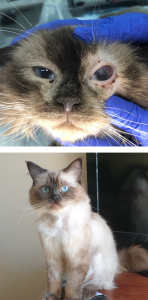 Morpheus (previously Muffin) the 1-year-old ragdoll arrived at the Home in mid-March looking seriously dishevelled, sporting sniffly nose and major eye infection. He was suffering from a severe melting corneal ulcer in his left eye – the worst our veterinarian Michelle had seen in her 10-year vet career.
Morpheus (previously Muffin) the 1-year-old ragdoll arrived at the Home in mid-March looking seriously dishevelled, sporting sniffly nose and major eye infection. He was suffering from a severe melting corneal ulcer in his left eye – the worst our veterinarian Michelle had seen in her 10-year vet career.
Given the severity of Morpheus’ ulcer, we knew we only had a small chance of saving his eye. We wanted to give him the best possible chance of recovery, so Michelle fostered him to provide round-the-clock care. She brought him to work each day, ensuring he received his treatments, medications and hourly eye drops for 2-weeks straight. She told us: “Not many cats would tolerate this much handling and medicating with sure a sore eye, but thanks to Morpheus’ easy-going nature, we were able to treat him so intensively.”
Against all odds, Morpheus’ corneal ulcer responded to treatment and resolved to reveal a beautiful blue-green eye underneath. While he waited for adoption, Morpheus chilled out at Michelle’s house and dished out cuddles to staff at the Home. Michelle told us: “He is by far the coolest little cat I’ve ever met with a very playful but cuddly and laid-back attitude.”
On 5 May, after a few adoptions fell through, Morpheus found his forever home with Sue and Geoff. They told us: “Morpheus is such a delightful cat. He lets us know when he uses the kitty litter for a number 2 with his morning meows so we remove it straight away. He follows us everywhere, even if we are showering. He just sits on the bath mat waiting. His favourite place is on top of then piano whilst Geoff practices his daily scales.”
Helping Your Dog Adjust to Post-pandemic Life
The COVID-19 pandemic has not only changed the lives of people, but of pets. For dogs especially, social distancing restrictions have meant their owners are home more often, paying them much more attention than usual. The hard part comes next, when we go back to work and school, and our dogs are left confused and upset at suddenly being left alone again. This is known as separation distress, and it’s every dog owner’s job to help their dog through it. We can’t explain to our dogs what is happening, so it’s going to take effort from everyone in the family to make this change as easy as possible for your dog.
To help with the transition, our Animal Care Manager and Veterinarian Dr Renae Jackson has provided five tips for managing separation distress as we return to work.
1. Gradually build up the length of time your dog is left alone
Before returning to work, dog owners can build up the length of time their dog is left alone until they are comfortable being left for prolonged periods. Start with periods as short as one second and build up alone time at your dog’s own pace. If your dog is distressed, take it back a step and progress more slowly. You can even make being alone fun, by pairing ‘alone time’ with your dog’s favourite chews, treat toys and games. Make sure they have access to their favourite safe resting place, and if you’d like, you can film your dog while you’re away to ensure you come back before they become distressed. White noise such as leaving the TV on at a low volume can help maintain a sense of normality.
2. Help them learn to be independent while you are at home
While it is lovely when your dog wants to cuddle and be near you, it’s important for them to learn how to be comfortable on their own. Use enrichment food toys and puzzles to keep them occupied in the lounge room while you are cooking in the kitchen. Encourage them to rest on a super-comfy bed of their own while you watch TV, not sit right on your lap. Creating short, frequent situations where your dog feels comfortable being on their own can really help to build their independence.
3. Keep your daily routine the same
Once your dog is comfortable with being alone, keep your daily routine the same. Leave the house and feed and walk your dog at the same time each day as you would when you go back to work. Dogs are less stressed when their life is predictable; they can rest easy knowing exactly what to expect. Do this before you go back to work so you can identify and work on any issues that may arise.
4. Understand that your dog is not doing ‘naughty’ things on purpose
If your dog starts showing unwanted behaviours such as barking, digging or chewing, it’s important to understand they are doing this because they are distressed, not because they are being intentionally naughty. Support your dog through this difficult time with calm, gentle teaching and never scold or punish them.
5. Seek help
Seek help for any signs of distress or changes in behaviour as soon as they appear. By enlisting the help of a force-free qualified dog behaviourist, you can be sure you are getting the right help to manage any behavioural issues before they get out of control.
For more information, we recommend the following resources:
Senior Pet Project: Herbert’s Winning Grin
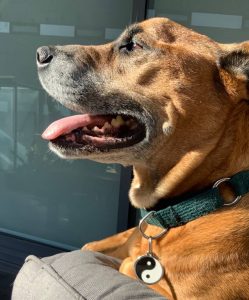 When Michael had to say goodbye to his dog at the end of a divorce, he walked into the Home in December 2019 hoping to find an older dog to share his life with. As he had a look in the kennels, he noticed 10-year-old Herbert, who had been at the Home for six months. Michael had seen Herbert in a video on our website and knew he’d had a rough past. He was brought in with anxiety and some health issues, but after a few treatments and some TLC in foster care, Herbert brought out his “big ol’ grin”, which got Michael hooked.
When Michael had to say goodbye to his dog at the end of a divorce, he walked into the Home in December 2019 hoping to find an older dog to share his life with. As he had a look in the kennels, he noticed 10-year-old Herbert, who had been at the Home for six months. Michael had seen Herbert in a video on our website and knew he’d had a rough past. He was brought in with anxiety and some health issues, but after a few treatments and some TLC in foster care, Herbert brought out his “big ol’ grin”, which got Michael hooked.
After seeing how much the staff at the Home loved Herbert, Michael signed the adoption papers and brought him home.
The first month was a bit rough, as it took Herbert a bit of time to settle into a new home and a new routine.Then sometime in week four, things settled down. Michael said, “Herbert clearly realised that this wasn’t another foster home – this was home. He sat down next to me on the couch, put his head in my lap, and fell fast asleep. And ever since then, he’s been the sweetest, happiest, and most obedient dog in the world.”
Today Hebert is a happy doggo who loves to sleep – on the balcony in the sun, in his bed, under the desk while Michael works, on the couch while watching TV – everywhere. He loves his walks and will go for five or six per day if he gets the chance. In fact, his walks have been keeping Michael sane while self isolating. Herbert also likes chasing balls, but Michael admits he’s not very good at the ‘giving the ball back’ bit.
Best of all, despite his past, Herbert loves people: “He wants to be best friends with every since person he meets, and the absolute highlight of his day is a scratch behind the ears from someone we’ve met out walking.”
We asked Michael what he loves most about Herbert and he told us: “Everything – from his happy grin, to the way he snorts and snores and chase bunnies in his sleep, the way he huffs like a grumpy old man when he doesn’t get his way, his sad eyes and droopy face, his sweet good nature, and the way he makes me feel both unconditionally loved and like I’ve given a sad old dog the loving home that he always wanted… Oh, maybe not everything. He farts like a trooper, but I forgive him for that because otherwise he’s just perfect.”
Thanks to the generous support of our community and those that donate to the Senior Pet Project, we were able to provide Herbert with the treatment and care he so justly deserved before he was adopted. If you’d like to contribute to the Senior Pet Project, you can donate here.
Archives
- February 2025
- January 2025
- August 2024
- July 2024
- June 2024
- April 2024
- February 2024
- January 2024
- October 2023
- September 2023
- August 2023
- June 2023
- March 2023
- February 2023
- January 2023
- December 2022
- November 2022
- October 2022
- September 2022
- June 2022
- May 2022
- March 2022
- February 2022
- December 2021
- November 2021
- October 2021
- September 2021
- July 2021
- April 2021
- March 2021
- February 2021
- January 2021
- December 2020
- November 2020
- October 2020
- September 2020
- August 2020
- June 2020
- May 2020
- April 2020
- January 2020
- November 2019
- October 2019
- September 2019
- August 2019
- July 2019
- June 2019
- May 2019
- March 2019
- January 2019
- November 2018
- October 2018
- September 2018
- August 2018
- July 2018
- June 2018
- May 2018
- April 2018
- February 2018
- January 2018
- December 2017
- November 2017
- October 2017
- September 2017
- August 2017
- May 2017




 MON-SUN:
MON-SUN:
 02 9587 9611
02 9587 9611 INFO@SYDNEYDOGSANDCATSHOME.ORG
INFO@SYDNEYDOGSANDCATSHOME.ORG







